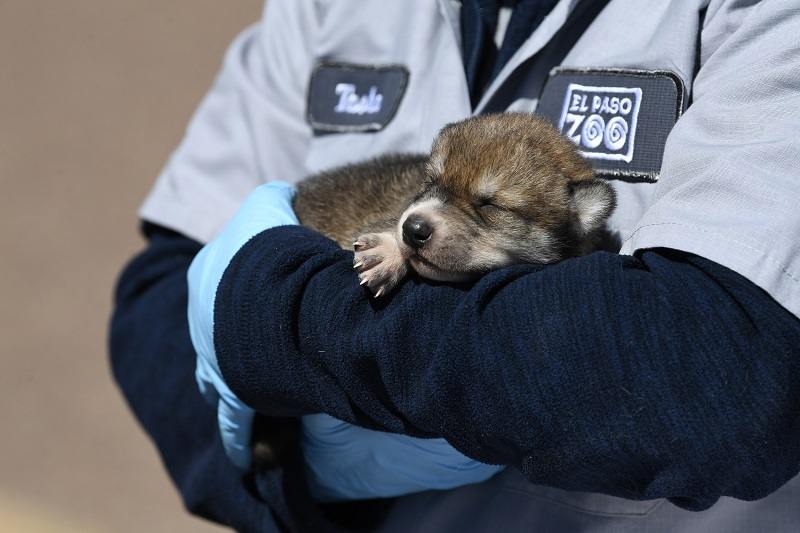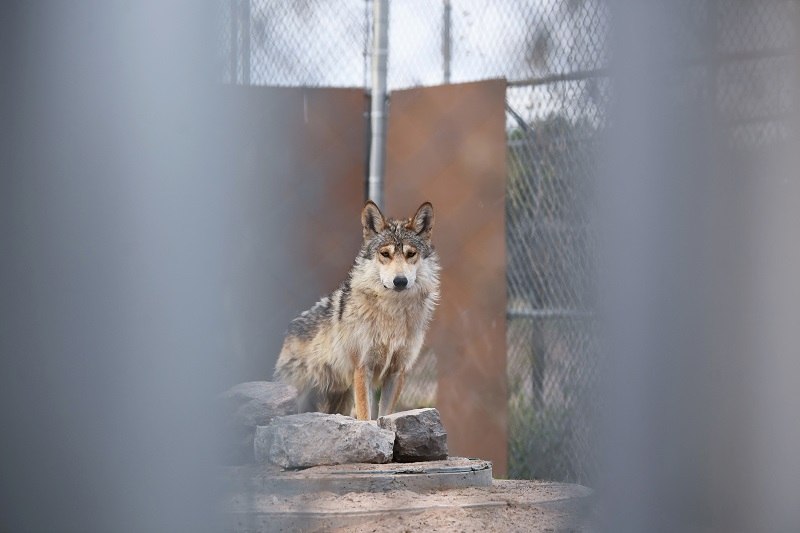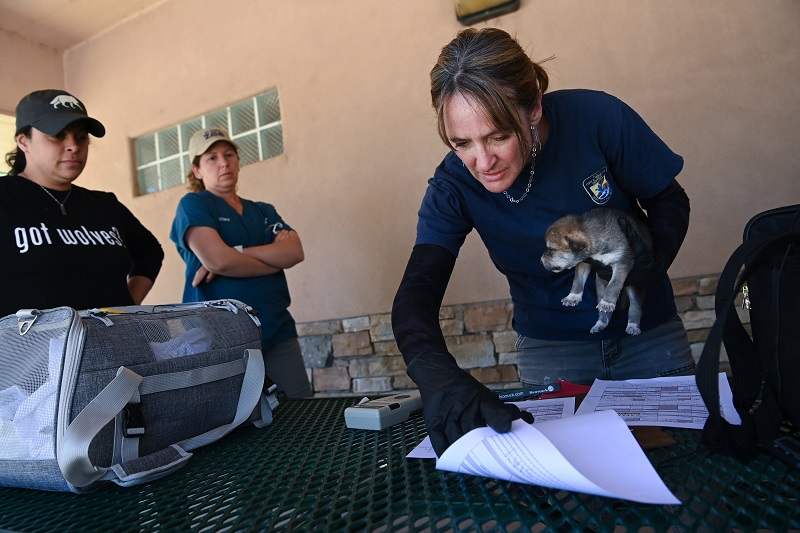Truck, plane, backpack: Inside the extreme effort to save Mexican wolves

Wolf pups are being trekked hundreds of miles to new homes in the wild to save the species from extinction.
13:24 JST, August 26, 2022
ABOVE THE GILA NATIONAL FOREST, N.M. – In a private plane soaring 26,000 feet over pine-swathed mountains, three tawny Mexican wolf pups slept. Their weight was less than three pounds each, their 10-day-old eyes still screwed shut. Their worth, as some of the newest members of a critically endangered species, was immeasurable.
The pups were protected by a soft pet carrier and kept toasty – 78 degrees, an attached thermometer indicated – by hand warmers wrapped in a towel. They were flanked by a veterinarian and a zookeeper, chaperones for this leg of a precisely choreographed operation.
The pups had been whisked from their birthplace, El Paso Zoo, two hours before. Their destination was the den of a wild wolf pack in the New Mexico mountains, where it was hoped the pups would be adopted into the pack, their genes bolstering an inbred population and helping to restore an apex predator and perhaps eventually providing a link in a chain of wolf populations stretching from Canada to Mexico.
Since the Pleistocene, wolves had populated what is now the U.S. Southwest and northern Mexico. But European settlers killed them off in mere decades after arriving in the region, and now people are trying to make amends with feats of logistics and technology. This is species recovery in the human-shaped Anthropocene, when an extreme extinction crisis is reflected in extreme recovery efforts – trucking salmon to cooler waters, wearing bird costumes to raise whooping cranes, and airlifting wolf pups to boost a wild population that has grown from zero to about 200 since a federal reintroduction program began in 1998.
The Washington Post got a rare up-close view of the mission to reintroduce Mexican wolf pups to the wild this spring – one that involved dozens of humans in four states; transportation by golf cart, pickup, Cessna aircraft and backpack; and a lot of hope.
Risks to the pups abounded in the rolling peaks below, and doubts about whether all the effort was worth it flourished far beyond.
Conservationists have sued the government over its Mexican-wolf management, which they and researchers say ignores science and sets the animals up for failure. Ranchers argue that wolves ruin rural livelihoods. And humans remain an enormous threat – poaching, cars and encounters with cattle have caused the deaths of nearly as many Mexican wolves as the number roaming the wild today.

An adult Mexican wolf is seen in an enclosure at El Paso Zoo, as workers prepare to retrieve pups for the cross-fostering program.
The recovery program is contentious enough that the U.S. Fish and Wildlife Service, which spent $2.8 million managing it in 2021, stopped introducing adult wolves, which ranchers and some officials say are more likely to be habituated to humans and be aggressive. So, for now, the agency has placed much of its hope on the tiny, furred shoulders of “cross-foster” pups like the trio on the plane.
“Rarely is conservation so hands-on,” said Vikki Milne, the zoo veterinarian, over the blast of the plane’s air conditioning.
Milne meant it. Soon, she was pulling on rubber gloves and reaching into the carrier. Newborn wolves do not urinate and defecate on their own; their mother licks them to stimulate the processes. For the next several hours, these wolves were between mothers – their birth mother in El Paso and their wild foster mother in New Mexico – so Milne would have to do it herself.
“We’re going to see if anybody has to potty,” Milne said, rubbing a cotton ball soaked in warm water between one pup’s hind legs. Its feet, studded with petite claws, stuck straight out. It yawned, revealing a pink tongue. Its eyes stayed closed.
Mexican wolves are North America’s rarest subspecies of gray wolves. They are smaller and browner than their Northern Rockies relatives, although scientists say it is likely they intermingled when wolves roamed the continent, before European settlement.
Deer may have been Mexican wolves’ main food source back then. But settlers’ livestock provided a new option, one that nearly doomed the canines. Across the Southwest, they were hunted and trapped in campaigns often aided by the government. Their population dwindled.
The last wild wolves, five straggling survivors, were captured in Mexico and taken into captivity in the late 1970s. Later, two other captive wolves would be determined to have distinct genetic lineages. Every Mexican wolf alive today is a descendant of those seven wolves.
About 380 Mexican wolves live in zoos and other facilities in the United States and Mexico, and they are inbred and, in scientific parlance, “genetically depressed.” The 200 or so in the “experimental population area” where the federal program’s rules allow the wolves to roam, straddling Arizona and New Mexico, are even more so – on average, as related as siblings. In 2018, a federal court ordered Fish and Wildlife to better manage the wolves’ dire genetic state, which threatens their health, reproduction and long-term viability.
The agency’s main approach today is flying zoo pups – with their more varied genetics – to the high desert within two weeks of their birth, driving them into the mountains, hiking them to a wild den, placing them in a litter born within 10 days of the zoo babies and hoping the wild mother “fosters” them. Dens are identified by GPS and radio telemetry data, which is available because about half of wild Mexican wolves wear radio collars.
The agency recently set a “genetic objective” of at least 22 cross-fostered pups surviving in the wild to breeding age, or 2 years old. So far, the agency says, at least 13 have done so.
The stars aligned for the pups from El Paso three days before their flight. Data indicated two packs known as Iron Creek and Dark Canyon – whose alpha females had previously cross-fostered – had new litters. So, just before 7 a.m. on travel day, zoo employees gathered outside the Mexican wolf exhibit. Over the drone of rush hour, Tasha Bretz, the supervisor of the zoo’s Chihuahuan Desert exhibits, gave orders like a military commander, outlining steps to herd adult wolves out of the den area and swoop in to retrieve the five pups, which staffers had so far glimpsed only via the den’s camera.
It was the zoo’s second time participating. “Last year was a stellar career event for me, pups going to the wild,” said John Kiseda, the zoo’s buoyant animal curator.
“If we have anybody who looks like they’re not healthy enough to go to the wild, then we’ll have to set them aside,” Milne told the group.
One zookeeper lowered herself into the den, a hideout the litter’s mom, Tazhana, had dug into a dirt hill. Another ferried the pups out to Milne.
Working quickly, she and another vet sorted them into crates – one for males, one for females. Bretz texted the field team: three boys, two girls.
Staffers put one male and one female back in the den, where, shortly, their mother would return to a smaller brood, a change that zookeepers say wolves seem to tolerate well.
Inside the zoo’s veterinary center, the team placed the wild-bound pups on an exam table. They checked for fleas. They recorded temperatures, heart rates and weights. Milne placed the pups on their backs to see if their “righting reflex” made them flip over. All was well.
“What else is on my list?” she said. “Body condition? Good. Nose is dry. Not swollen. Palate is good. Anus is good.”
Soon, the pups were riding in a pickup on Interstate 10 to the airport, where the Cessna Citation – piloted by a volunteer with Lighthawk, a flight organization that supports conservation projects – waited.
– – –

Rebecca Bose, left, of the Wolf Conservation Center in South Salem, N.Y., and El Paso Zoo’s Milne watch as Susan Dicks, a veterinarian with the U.S. Fish and Wildlife Service, checks a captive-born Mexican wolf pup that is about to be placed with wild wolves.
The plane landed about 300 miles away in Springerville, an Arizona town at the edge of Apache-Sitgreaves National Forests. An Arizona Game and Fish Department team was waiting, ready to help with the pups’ next step: a meal of puppy formula.
Reintroduction wasn’t always this way. The first 11 Mexican wolves released, in 1998, were three family groups. It was a rocky start: Six had been slain by the end of the year, according to an account by the recovery team leader. But over time, they bred – and spread.
Opposition in the states nearly ground releases to a halt between 2007 and 2015. During that time, scientists advising Fish and Wildlife recommended aiming for three separate U.S. populations totaling 750 Mexican wolves, some of which would roam into Utah and Colorado, where Northern gray wolves have begun to reestablish themselves.
Governors of those states, as well as Arizona and New Mexico, hotly objected – publicly and in conversations with Dan Ashe, then-director of U.S. Fish and Wildlife. In what Ashe called a compromise, the agency greatly expanded the recovery zone – but drew its northern boundary at Interstate 40, south of the Grand Canyon. Today, officials retrieve most wolves that stray beyond.
In an interview, Ashe said he thinks the wolves should be able to travel north: “Our recovery objective for wolves should be to restore a metapopulation.”
Suspending the release of adults was another compromise, Ashe said. But Ashe, who now heads the Association of Zoos and Aquariums, sees promise in cross-fostering – as a real-world use for zoo breeding programs and as a model for other rare species, such as cheetahs.
At the Springerville airport, another Cessna landed. It came from New York, flown by a volunteer who said he had previously ferried leopards, lynx and monkeys. His passengers were one 9-day-old female wolf pup, a veterinarian and a keeper from the Wolf Conservation Center in South Salem.
The New York pup would join the three from El Paso. Two would go to Iron Creek, two to Dark Canyon. These would be the final four cross-fostered pups this spring, bringing the total to 11.
The center, its executive director, Maggie Howell, said later, was delighted the pup would have “the wild life that all wolves are meant to have.” But she would prefer to send bonded pairs and families – proven breeders who could contribute to the gene pool faster. The idea that 22 cross-fostered pups will make an impact “I think is misleading,” she said. Other conservationists and scientists agree.
Of 72 pups cross-fostered between 2016 and 2021, 16 have been confirmed to survive to their first birthday, Fish and Wildlife says, although the agency estimates that closer to 50% may have made it. Of the 13 known to have reached breeding age, at least four have produced litters, and three more were breeding this year, officials said. The agency says those numbers, combined with steady overall population growth, means cross-fostering is working.
“We’re showing biologically it works, and socially, it’s more tolerable to the people who live here,” said Paul Greer, Arizona’s Interagency Field Team leader for Mexican wolves, a star-shaped badge and a firearm on his belt.
The next stop for the pups and their entourage: A desolate ranger station near Reserve, N.M., where they met a Fish and Wildlife team from Albuquerque. At a shaded picnic table, agency veterinarian Susan Dicks examined the wolves, affectionately comparing them to baked potatoes.
“All right, I think this is the pair that will go to the Iron Creek den,” Dicks said, holding the smaller El Paso male and the New York female.
The teams set out again in a convoy of government pickups. On the winding road to Iron Creek, John Oakleaf’s dusty radio crackled with reports from crews already at the sites. Oakleaf, a Fish and Wildlife biologist, is the ringmaster of the cross-foster operations as well as point person for area ranchers, who are told when new pups are placed on land their cattle graze.
“I think the one thing we agree upon is that we don’t want wolves to kill cattle,” Oakleaf said as the truck bounced along. “Because that leads to removed wolves. Environmentalists don’t want wolves removed . . . and ranchers don’t want their cows dead.”
“So we all agree,” Oakleaf said. “In theory.”
Many ranchers aren’t fans of Mexican wolves. In a recent statement, the New Mexico Cattle Growers’ Association said the recovery program is “being wielded as a tool to remove people from the landscape.” In May, Rep. Yvette Herrell, R-N.M., called for the destruction of a pack – whose alpha male was a cross-foster – that she said was “terrorizing” ranching families.
The Iron Creek and Dark Canyon packs had been chosen for cross-fostering in part because they are not known for killing cattle. Wolves’ diet is about 80% elk, Oakleaf said, and about 10% cattle.
Over the years, the agency says it has “lethally removed” 20 Mexican wolves for killing or bothering livestock. A new agency rule limits lethal removals, in part to prevent deaths of genetically important animals.
In response to a 2021 court order, the agency also pledged to better combat poaching.
Those steps are insufficient, said Michael Robinson of the Center for Biological Diversity.
“Almost none of the 100-plus known illegal killings have actually been taken to court,” Robinson said. The agency, he said, “has delegated the destruction of endangered wolves to wolf haters.”
Despite the polemics, Oakleaf said he enjoys his job. He worked for a time with goshawks, he said, and “people didn’t really care.” That’s hardly the same with wolves. “I’m interested in trying to find that balance.”
Around 2 p.m., Oakleaf turned into the staging area for the Iron Creek pup deposit, a clearing surrounded by pines. Two other trucks, one carrying the two pups, followed. He picked up his radio to tell the crew up the mountain it was time to find the den.
“Copy that,” a woman responded. “We’ll go ahead and start our search.”
– – –
GPS and radio telemetry data had given the scouting team a good idea of the Iron Creek den’s general location, and Allison Greenleaf, another Fish and Wildlife biologist, had a hunch it might be one the alpha female, known as AF1278, had used before: beneath the root ball of a downed tree.
She was right. As Greenleaf and a colleague got close to the site, the pack retreated, howling from atop distant logs.
Down at the staging area, the pups – which, like human infants, needed to eat every three to four hours – were again being tube-fed puppy formula. One pup pooped, and Dicks reached down to pick up the dropping: It, like all the urine and feces the wolves produced this morning, would be rubbed on the wild pups. That would make all the pups smell the same, increasing the chances the mother would accept the newcomers.
“Don’t poop on my head!” Dicks said, laughing. “I’ve gone home with endangered species poop in my hair more than once.”
Soon, two team members were placing the pups, now known as mp2722 and fp2736, into a gray backpack. They took a short drive, then hiked 20 minutes up a hill to Greenleaf and her partner.
“Now they have to live at least two years,” Dicks said, leaning against a pickup. “We believe they do great with the fostering, but then they are basically subject to whatever a wild puppy is subject to, living in the wild: other predators, disease, drought, famine.”
Shortly before 4 p.m., a radio broadcast news from the Iron Creek den. “They found the den!” Dicks shouted. “There’s six pups in the den!”
Up the mountain, Greenleaf slid on her stomach into a sliver of space under the root ball, then passed the wild pups out to her partner through what she called a “skylight” in the exposed roots. They placed the eight squirmy pups on a red blanket beneath waving pines, checking all of them for their sex and condition, rubbing them with excrement and urine.
Within 30 minutes, the wild pups were back in the den, now with two foster siblings. Greenleaf slid back out, brushed off some of the dust that covered her, and fist-bumped her partner.
And that was it: Less than 11 hours after their multistate and multivehicle odyssey began, the pups’ wild existence had started – one far different from their ancestors’. They might someday be fitted with radio collars. They would live outside zoo walls but inside boundaries drawn and argued over by humans.
And they would be watched. That afternoon, the team placed a camera near the den, for monitoring the pups when they emerged to face the uncertain world outside.





